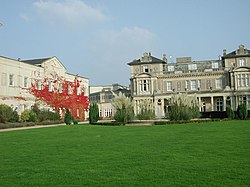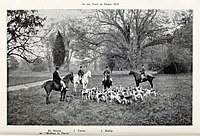Down Hall: Difference between revisions
Created page with "{{Infobox house |name=Down Hall |county=Hertfordshire |picture=Down Hall Country House Hotel from the rear gardens - geograph.org.uk - 451750.jpg |picture caption=Down Hall Co..." |
|||
| Line 38: | Line 38: | ||
After its sale, the house was used as a school (Downham School, 1932–c.1967) and an antiques business and conference centre (1967–1986). | After its sale, the house was used as a school (Downham School, 1932–c.1967) and an antiques business and conference centre (1967–1986). | ||
In 1986, the estate was purchased by the Veladail Group, who have operated the site as a four star hotel, conference centre and wedding venue since. | In 1986, the estate was purchased by the Veladail Group, who have operated the site as a four star hotel, conference centre and wedding venue since. | ||
Down Hall today is surrounded by 110 acres of woodland, parkland and landscaped gardens, some of which is protected by the Essex Wildlife Trust. | Down Hall today is surrounded by 110 acres of woodland, parkland and landscaped gardens, some of which is protected by the Essex Wildlife Trust. | ||
Latest revision as of 21:11, 13 June 2019
| Down Hall | |
| Hertfordshire | |
|---|---|
 Down Hall Country House Hotel | |
| Location | |
| Location: | 51°47’45"N, -0°12’24"E |
| Village: | Hatfield Heath |
| History | |
| Built 1873 | |
| For: | Henry Selwin-Ibbetson, 1st Baron Rookwood by Frederick Pepys Cockerell |
| Country house | |
| Neo-Elizabethan | |
| Information | |
| Condition: | Converted to hotel |
| Owned by: | Veladail Group |
| Website: | http://www.downhall.co.uk |
Down Hall is a Victorian country house and estate near Hatfield Heath in Essex, close to its border with Hertfordshire.
History
The first Down Hall was a Tudor house, once owned by poet Matthew Prior.[1] Prior was acquainted with landscaper Charles Bridgeman, whom he commissioned to landscape the estate's gardens. After Prior's death in 1721 (just one year after buying the property), the house was passed to his friend Edward Harley, 2nd Earl of Oxford and Earl Mortimer, who undertook further rebuilding. Twenty years later, and with the house still unfinished, Harley died.
Selwin family

On Harley's death in 1741, the house was purchased by William for £4,500.[1] The estate remained in the Selwin family, albeit that when the estate passed through the female line to Charles Ibbetson in 1816, he changed his surname to his mother's, becoming Charles Selwin. The new-minted Charles Selwin owned Down Hall for only nine years when in 1825 he inherited the Ibbetson family title as Baron Rookwood and removed to the family's Yorkshire seat, leaving his youngest brother John Thomas to inherit the Hall, from whose day the family styled itself Ibbetson-Selwin.
In 1873, Henry Selwin-Ibbetson, who was created Baron Rookwood, commissioned Frederick Pepys Cockerell as architect to effect a complete rebuilding of the old hall, to the create the building now standing.
In 1902 however, Lord Rookwood died and with him the Selwin and Ibbetson lineage died out.
First World War and afterwards
During the First World War, the house was used as a sanatorium for wounded soldiers.[1]
The estate was affected by the recession which followed the First World War, and was subsequently sold at auction.
Modern history
After its sale, the house was used as a school (Downham School, 1932–c.1967) and an antiques business and conference centre (1967–1986).
In 1986, the estate was purchased by the Veladail Group, who have operated the site as a four star hotel, conference centre and wedding venue since.
Down Hall today is surrounded by 110 acres of woodland, parkland and landscaped gardens, some of which is protected by the Essex Wildlife Trust.
Outside links
References
- ↑ 1.0 1.1 1.2 History of Down Hall - Down Hall